
Olen Zellweger is a key piece of the Ducks' future blue line.
Olen Zellweger is a key piece of the Ducks' future blue line.
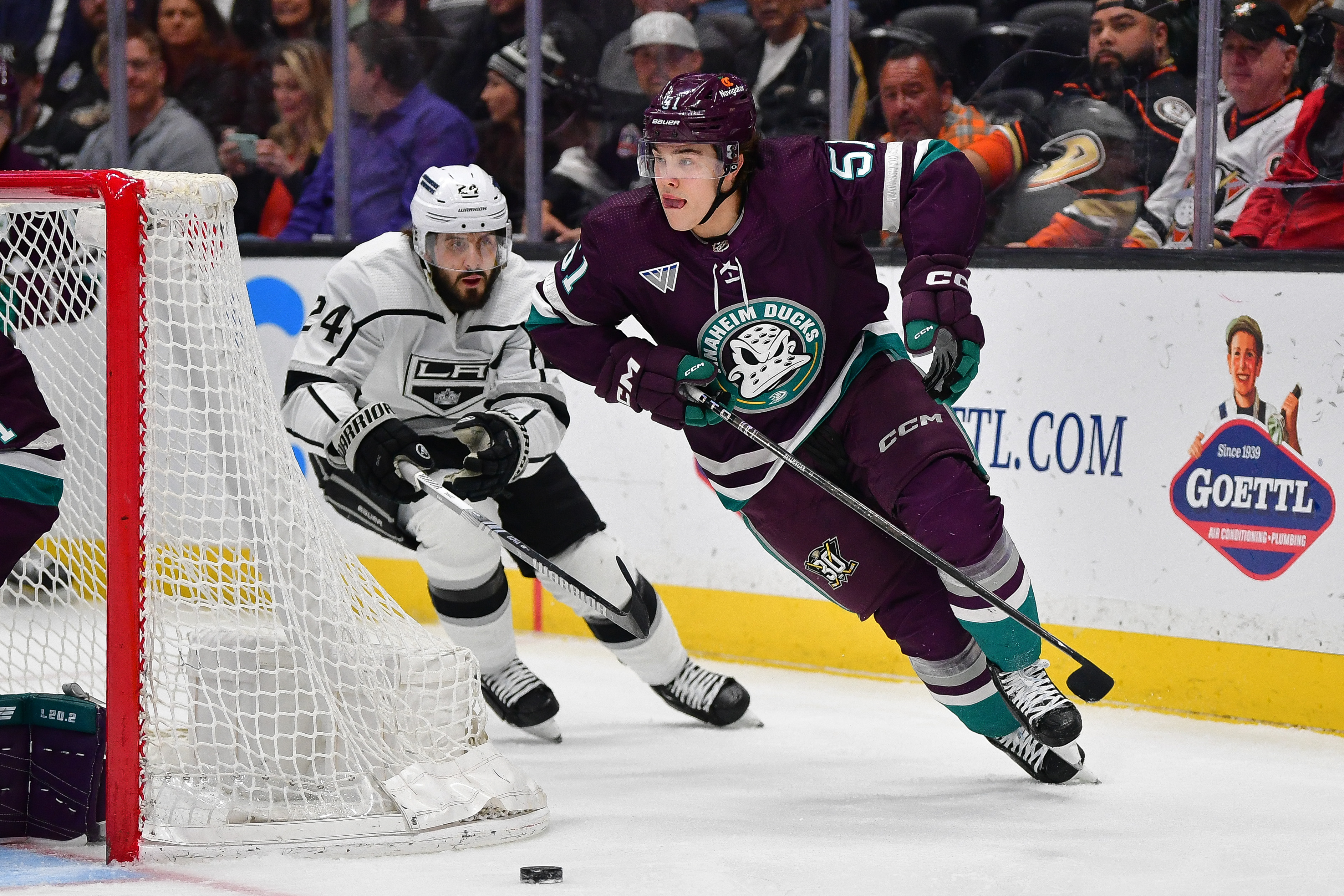
Olen Zellweger is part of the Ducks’ future. That much is clear. The 20-year-old defenseman was drafted 34th overall in the 2021 NHL Entry Draft—as one of the youngest players in that draft, no less—and has risen to new heights at every level since then.
Zellweger concluded his CHL career after the 2022-23 season and began this season in the AHL with the San Diego Gulls. At one point during training camp, it appeared that Zellweger could be destined for the opening night roster. However, Ducks management felt it best for the offensive-minded defenseman to get top-pair minutes while continuing to improve his defensive play.
[embed]https://www.youtube.com/watch?v=49JQzEr9POQ[/embed]
“I think that the development down (in San Diego) has been really good with the coaching staff,” Zellweger said. “Lots of good feedback that I’ve thought has possibly increased my gameplay performance.”
Zellweger spent the first half of the season with the Gulls, collecting 25 points in 34 games before being called up to the Ducks on Jan. 23.
It didn’t take him long to make an impact either, as he grabbed his first NHL point in his first game against the Buffalo Sabres. His shot from the point was deflected and eventually batted in by Sam Carrick into the net.
“It was great,” said Zellweger after that game. “It was awesome to get the win. I was really excited there in the first few shifts, we were really good out there. Great experience for the first game.”
He would only get four games in before the All-Star break, heading up to San Jose to participate in the AHL All-Star Game after being named the Gulls’ representative.
“That’ll be cool,” said Zellweger at the time. “I’ve never done anything like that before so I’m looking forward to it.”
A return to the AHL was what greeted Zellweger coming out of the All-Star break and he responded with seven points in those first four games. Not only that, but he was now playing on the right side as a left-handed defenseman. 10 games later, he was back up with the Ducks.
“I think it helped going back for a little bit,” he said. “Now, I’m just trying to get back to feeling good out there with the speed and getting used to the guys on our team again.”
“There’s some differences,” said Zellweger on playing his off-side. “But I feel pretty comfortable there. I think I’ve played probably like 15-20 games (in San Diego) on my right side. The first two games, I felt like I was almost lost. It’s just like everything is a different direction when you’re gapping up and stuff.”
“I played the right side a lot in juniors and World Juniors. It’s nothing too new to me, I did it quite a bit. But other than that, there are some other differences from your strong side.”
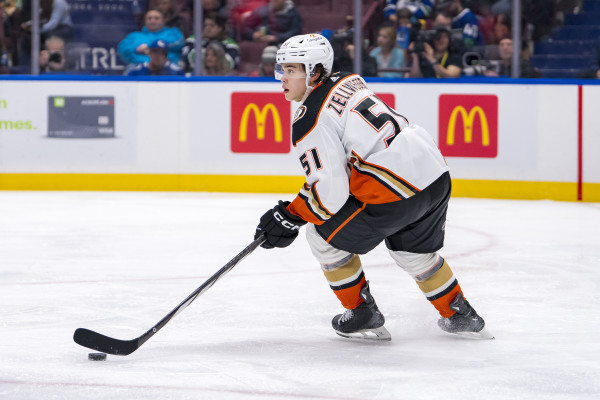
Upon his return to Anaheim, Zellweger was paired with Cam Fowler, the longest-tenured member of the team. Fowler had many young defense partners throughout the season before he and Zellweger became a pair.
“He’s got great skating ability, so I think we kind of can complement each other around the ice,” Zellweger said. “Good skating and communication. Just lots of small teaching points he’s been pretty good with me on.”
“He’s done a really nice job,” Fowler said. “I think he’s got tremendous talent (with) the way that he can skate and the way he sees the ice is next level.”
“I’ve been trying to work with him a little defensively so that we can be responsible when we’re on the ice because sometimes both of us want to get up in the play. We’ve got to make sure that we’re reading off of each other.”
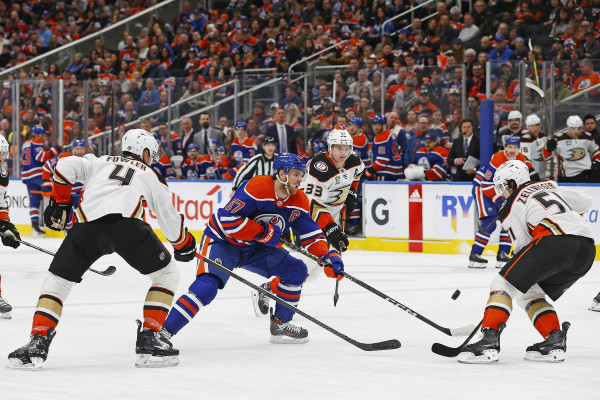
“He’s going to be a great player for a long time. He’s done a really nice job and he should be proud of everything he’s done so far.”
“Everybody’s primary target in terms of identifying growth for him in the NHL is his defense, his ability to defend as a smaller defenseman, right?” Ducks head coach Greg Cronin queried. “There’s some big guys on the ice and when you’re a smaller guy… I mean, he’s five-foot-nine. He’s obviously in good shape, he’s a thick kid.”
“He’s at a disadvantage when it comes to size and length. People get sticks around him and step inside of his hands and then if you don’t have the additional or the matching length, you’re not going to be able to knock pucks free.”
“He’s aware of that, so I think the big thing he’s going to have to manage in the NHL is called lane management. Get between the attacker and the net and use his strength, his thickness to take away sticks and bodies.”
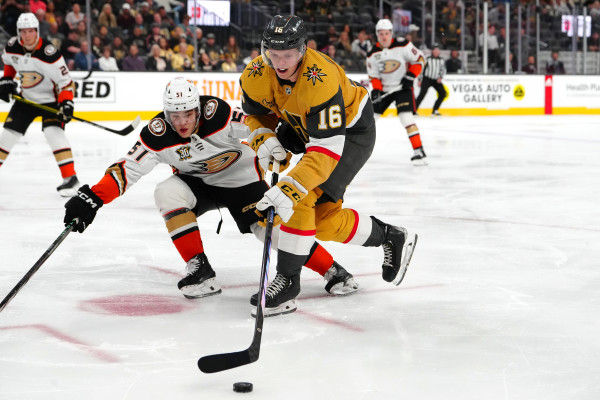
While it’s no secret that Zellweger is smaller than the average NHL defenseman, he’s no pushover either. Spend even a moment off the ice with him and you’ll notice how much muscle mass he has and how well-built he is. Zellweger lives in the gym and is frequently the last player to leave the ice, whether it’s a practice or a morning skate.
“You can kind of go down the list of every skill you need and he’s got it,” said Connor Bedard, who was drafted first overall by the Chicago Blackhawks last summer and played with Zellweger at World Juniors for Team Canada last year. “I got to spend some time with him and his work ethic is just unbelievable. He’s going to be a great player. He’s fun to watch.”
Logan Stankoven, who was teammates with Zellweger in the WHL and with Team Canada in the World Juniors as well, is also a player of smaller stature. That hasn’t stopped either of them from carving out a role in the NHL.
“He’s such a gifted player and loves to win,” said Stankoven of Zellweger. “He’s really competitive. I think it’s definitely encouraging when you see small guys have success. I think it’s good on teams when you can have a mix of both.”
“Can’t have a team full of big guys and can’t have a team full of small guys, so it’s good to have a mix of both. I think every player brings a different aspect to the game.”
Zellweger wants to continue working on his puck skills to become more elusive and harder to contain. As a smaller player, the shiftier and more agile he is with the puck, the more often he can avoid being contained, in his mind.
“On defense, if I’m always in a guy’s face, my feet or my body’s a lot lower than theirs,” Zellweger said. “I can knock them off the puck or knock them off balance. I think there’s lots of advantages, especially as a more offensive player.”
“He’s a real coachable kid,” Cronin said. “I think we all weren’t sure what he was going to be at training camp because of his lack of length and size. But his heart is huge and he’s tremendously tenacious and I know he knew and I think (Gulls head coach Matt (McIlvane) and his staff did a great job educating him on the importance of staying between the attacker and the net. Because if he gets on the wrong side of people, he doesn’t have the length to recover pucks.”
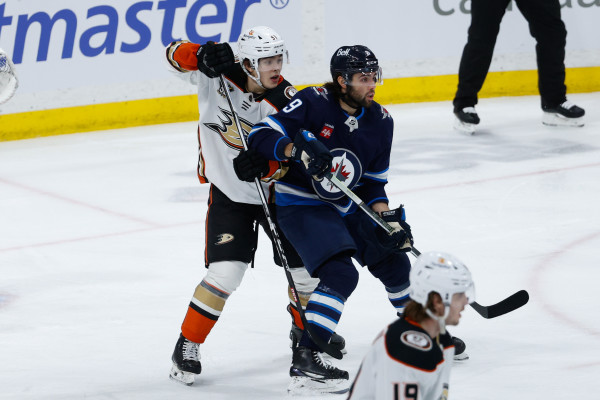
“I just think he really wants to win, he’s a winner. What he does at the offensive blue line for us is what we desperately need, which is that lateral mobility with his head up. He can find targets whether it’s a stick blade or a screen at the net. He’s dynamic coming down the walls. He makes a decision whether he keeps it or drops it to a forward coming up the wall.”
“And he’s going to get better because I think he’s a real student of the game and he’s learning and he’s continuing to try and find ways to improve.”
Zellweger credits McIvane with being transparent with him and helping him become more of a complete player during his time in San Diego.
“We’ve had numerous video meetings and conversations that I think overall have really helped me progress in areas that I was maybe not as strong in before.”
“There’s so much more structure (in pro hockey),” Zellweger continued. “It’s way more organized. I think in the CHL, guys want to go at their own pace. Skate it end-to-end or kind of do your own thing on the power play, whatever that may be."
"Now, (in pro hockey), there’s not really any of that, right? You use your skills within the team’s system. Otherwise, you won’t find much success, I don’t think there are maybe a few guys around the league that have that ability that they’ve earned to kind of go on their own.”
“I think that’s the biggest difference, there’s so much more structure. You’ve got to be so much more aware. (Being) positionally sound on defense for sure is another huge thing that maybe is more lenient in junior where the positioning on D wouldn’t cost you as much because they maybe don’t bury every chance or you can make up a mistake with a hit or skating. I think it’s been a good adjustment. My first few games here have been really fun and I think I’m learning a lot, which is really good for my development.”
Zellweger finished his rookie campaign of 26 games with nine points, which included two goals. His first NHL goal was a short-side snipe in Vancouver against the Canucks.
Growing up in British Columbia, his parents made the short journey to see him play and were able to see him score his first NHL goal in person. Zellweger’s parents were also there for his first NHL game and first NHL point.
“That was pretty cool for them to come (to Vancouver) and for (my first NHL goal) to happen,” he said. “It’s a great memory, especially for them. They made a lot of sacrifices for me to get here.”
Though Zellweger demonstrated that he can handle the rigors of playing his off-side if needed, especially with the left side of the Ducks’ blue line a bit crowded in the present, words from general manager Pat Verbeek in his end-of-season interview with Alexis Downie on Ducks Stream appear to indicate that may not be the case heading into next season.
“We actually put him in a really tough position in the sense that he played his off-side, which is very difficult for (even) the best of veterans to handle and I thought he did a very good job.”
Whether he’s playing on the left or the right side next season, it appears that Zellweger is beginning to cement a spot on the Ducks’ blue line.
